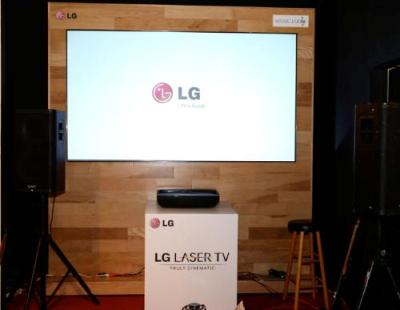Jan 20 2014
Google has just announced its latest high-tech marvel: contact lenses for diabetes patients. The lenses are lined with microelectronics that can monitor blood glucose levels in tears and then wirelessly transmit the data to a handheld device.
 VIP guests will watch football playoff action on LG's 100-inch Laser TV at the LG Music Lodge at the Sundance Film Festival on Sunday, January 19, 2014. (PRNewsFoto/LG Electronics USA, Inc.)
VIP guests will watch football playoff action on LG's 100-inch Laser TV at the LG Music Lodge at the Sundance Film Festival on Sunday, January 19, 2014. (PRNewsFoto/LG Electronics USA, Inc.)
This innovation might mean that diabetes patients would no longer have to draw blood by pricking a finger to measure their glucose levels up to several times daily. According to Google, the prototype contacts will take at least five years to reach consumers; testing is still ongoing to measure precisely how glucose levels in tears correlate with levels in blood.
Yet Google is far from the only company innovating pain-free, non-needle glucose measurement systems—and some are already fully ready for the market. One man who knows this better than most is Avner Gal, the President and CEO of Integrity Applications. Based in Ashkelon, Israel, Integrity has developed the GlucoTrack® model DF-F noninvasive blood glucose measurement device. Much like Google’s lenses, GlucoTrack is designed to help people with diabetes obtain blood glucose level measurements without the pain, inconvenience, incremental cost and difficulty of conventional (invasive) spot finger stick devices. But GlucoTrack’s focus is not the patient’s eyes, but the ear lobe instead.
The GlucoTrack device takes advantage of the natural physiology of the ear lobe and uses an ear lobe clip to deliver blood glucose readings in about a minute, thanks to a trio of technologies: ultrasonic, electromagnetic and thermal. In June 2013, Integrity Applications received CE Mark approval for the GlucoTrack DF-F model device. As a result, Integrity may sell the device in the 28 member states of the European Economic Area, although it has not yet commenced sales.
There are two components to the GlucoTrack DF-F device: the Main Unit and the Personal Ear Clip (PEC). Supporting up to three different users, the Main Unit is similar to a smartphone in size, weight and functionality. It features an easy-to-use touchscreen, uses a built-in lithium-ion rechargeable battery and includes a USB port for data downloading. The device both displays and speaks out loud the results of a blood glucose reading (making this ideal for the blind user), and has memory capacity large enough for 1,000 readings per user. The PEC is comfortable and adjustable, individually calibrated, and has an operational lifespan of up to six months (although more frequent replacement or recalibration might initially be required by some regulatory authorities), which cuts down on costs.
Why use the ear lobe as the monitoring site? From a usability point of view, the ear lobe is nonintrusive, so utilizing it for blood glucose monitoring is convenient for the user. More importantly, the ear lobe contains a large number of capillary vessels, and the flow of blood within it is relatively slow, thus providing favorable conditions for obtaining measurements. In addition, the relatively small amount of fat and nerves in the ear lobe, as well as the lack of bones, reduces the “noise” and thus helps to ensure a good reading. In addition, the ear lobe remains stable in size over an adult’s lifespan, which lengthens the period of time for which a calibration will remain valid, because users do not have to adjust the PEC due to a change in ear lobe size.
As a noninvasive device, GlucoTrack does not measure blood glucose levels directly; instead, it harnesses three independent technologies to measure physiological phenomena that correlate with the user’s glucose level. These measurements—which are transmitted from the PEC to the Main Unit—are subsequently analyzed using an algorithm that translates them into blood glucose level readings. Significantly, GlucoTrack does not use optical technology, which, based on others’ experience, was found to be impractical for use in noninvasive glucose monitoring.
Once calibrated, the GlucoTrack model DF-F is able to measure blood glucose levels at any desired time, making it the right solution for a wide range of diabetes patients. Although CE Mark approved, it is not yet available for purchase, since Integrity is still in the preparation phase for production. The company has however recently signed a distribution agreement for GlucoTrack in Australia and New Zealand, and a separate distribution agreement in Turkey. The device is expected to be available within the European Economic Area during the first half of 2014. Integrity also intends to apply for clearance from the U.S. Food and Drug Administration to market the GlucoTrack model DF-F in the United States. If and when Integrity Applications obtains FDA clearance for GlucoTrack, Americans with diabetes might also benefit from access to this noninvasive technology.